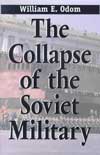
Issue #09/90, May 11 - 25, 2000 

By John Dolan
Gorby The Terrible: U.S. General Agrees
|
The Collapse of the Soviet Military |
This is very strange history, and it leaves us trembling and disappointed, like a middle-class child who expected a fight with the school bully who failed to show. The subjunctive Third World War: what would have happened if the Soviets had sent their tanks? And why didn’t they? Why did they fade away without a fight? What happened to all that steel aimed at the Fulda Gap? A few images, cliche as soon as broadcast, stand in place of an answer: Russian trucks pulling out of East Germany; MiG-25 rides for software millionaires visiting Moscow; the Black Sea Fleet rusting at anchor, unclaimed. Beyond this only the gloating of the western press, their bland certainty that all this was ordained by God.
You’d expect William Odom, an American general, to share the glee and smugness of the Western press. He doesn’t. Odom looks at the defunct Soviet military much more carefully than have civilian assessors, and concludes that the Soviet military fell apart largely because Gorbachev wanted it to do so. This is the same conclusion advanced by angry Russian nationalists–and routinely dismissed as paranoid. It’s not so easy to dismiss when made by a high-ranking American officer.
Odom demolishes many of the more smug conclusions drawn from the collapse of the USSR, particularly the notion that since the Soviet military fell apart so easily, it would never have been able to stand up to NATO. Taking on the question directly, Odom asks, "Was the Soviet Military a Paper Tiger?" and answers very simply: no. He grants the Soviet weaknesses: too few NCOs, ethnic hatred, a corrupt senior staff–and yet makes it clear that the Soviet Army could still have mounted a terrifying blitzkrieg if it had been given the order. As he explains, an army that does badly when sitting in barracks is not necessarily an army that does badly in battle. In fact, the Soviet Army would probably have done much better in war than in peace:
"Would Soviet troops… have performed effectively? Would the junior officers have demonstrated sufficient initiatives? … The outbreak of war would have sublimated many of the social and political problems within the military’s ranks. What the Soviet Army could not endure was continuing peace…. War in Central Europe could have been its salvation."
Like many researchers whose ostensible aim is to eradicate the object of their study, Odom has had to fall a little bit in love with his specialty, and he writes of Soviet military culture with far more understanding and knowledge than you’d expect. If there’s a failing in the book, it’s that Odom spends so little time on Soviet military adventures themselves, focusing instead on the organizational quirks of the military/industrial/ideological complex. He mentions only in passing episodes like the border war between Russia and China along the Amur, and spends only a few pages on the war in Afghanistan.
His chapters dealing with the hierarchy of the defense industries makes fairly heavy reading, and I can’t really claim to have retained much of his explanation about the relation between industrial suppliers and military clients. But even in this, by far the least exciting part of the book, Odom makes interesting claims. His explanation of the impossibility of a military coup against Gorbachev, based on his analysis of the integration of Party and military organizations, answers one of the great questions of the last decade: why didn’t the generals get rid of Gorbachev when they knew he was destroying the military? Odom’s answer is quite radical: "… by 1991, the Party was too weak to control the military… and the military leadership was too corrupt, weak, careerist, and indecisive to act on its own. Most senior officers were either unwilling to take the risk or concerned only with their own careers." Odom’s estimate of the insurrectionary potential of the military in Gorbachev’s last years is so low that he concludes that the "coup" of 1991 was much more likely to have been staged by the "Reformers" as a way of discrediting and eliminating all potential opposition by the remnants of the Soviet military/political cadre. Again, Odom’s thesis is very different from that of the Western press and surprisingly close to the oft-derided interpretation of events given by Russian nationalists.
Throughout the book, Gorbachev looms as a strange Satanic figure, clever in surface things and utterly misled about the bedrock realities of the system he led. His story is bookended by two figures: Lenin at the beginning, reinterpreting Marx based on his reading of Clausewitz in order to forge a war-based theory of Socialism, and Gorbachev at the end of the story, bringing down the entire structure under the delusion that he could tear down its stress-bearing beams without destabilizing it. Odom notes that Gorbachev was the first Soviet leader without military experience, and that this inexperience, like Gorbachev’s ignorance of the non-Russian areas of the USSR, led to a fatal naivete about the system. Gorbachev saw the military as an obstruction to his reforms, and set about weakening it without realizing what even the fool Nicholas II realized: that the Army has always been the heart of the Russian state.
Odom’s account of Gorbachev’s war with the Soviet military highlights incidents like the flight of Mathias Rust, who landed his Cessna in Red Square in 1987. In the West, Rust was seen as an icon of spunk and a harbinger of peace, a little dove that managed to fly to the very heart of the enemy’s heartland with its single-engine "message of peace and cooperation" and so on. Not so for the Soviet military, and particularly the Air Defense Command which, as Odom notes, constituted one of the five basic divisions of the Soviet military machine. Rust’s flight, which Soviet defenses had apparently failed to intercept, shamed the Russian forces and turned Gorbachev to bitter hatred of the whole defense complex. Something of the atmosphere of defeat which had already begun to soak through the Kremlin comes through in Odom’s anecdote about the meetings called to discuss the Rust incident:
"A former Soviet colonel and specialist in air defense characterized the event’s significance simply: ‘Rust won the strategic competition.’ Asked to elaborate, he described the change in civilian attitudes toward his uniform when he walked on the streets of the city where he was stationed at the time. He sensed their scorn and feeling of betrayal."
Odom interweaves anecdotal evidence like this with more academic arguments very skillfully. He has a knack for choosing the right moment, as when he describes the weirdly giddy, hysterical reaction of the Politburo itself to the Rust flight:
"At a Politburo meeting, Viktor Chebrikov was giving the KGB’s report on Rust’s debriefing for a decision about what to do with him…. Chebrikov recommended that Rust be turned over to the German court in Hamburg, which had already indicted him. But Lev Zaikov objected, ‘If this young lad had landed in front of the White House in Washington, what would they have done with him?’ Chebrikov answered, ‘In the first place, they would have shot him down,’ provoking an outburst of laughter. Gorbachev grew furious [and] delivered the Politburo a lecture on jesting about such a serious matter…."
This remarkable moment sums up Odom’s story of the collapse: Gorbachev knocks away the props of a fragile system, then gets angry when it falls. Mathias Rust made his flight precisely because Gorbachev had convinced Europeans that Russia was a changed, friendly place. Rust’s first request when he landed in Red Square was to see Gorbachev.
Odom’s portrait of Gorbachev may be the best I’ve read. Gorbachev as reported by the Western press never seemed quite believable–a nice progressive bald guy with a birthmark who had somehow risen to the top of the scariest hierarchy in the world while preserving the outlook of a Berkeley social worker. Odom presents Gorbachev as something else entirely: an anti-Lenin, as avid in unmaking the Soviet system as Lenin was in making it, and with Lenin’s terrible grasp of the mechanics. Odom suggests that Gorbachev was a brilliant tactician, devising a thousand subtle ways of bringing down the Soviet military, which he saw (especially after the Rust incident) as the biggest obstacle of his campaign to remake the Soviet Union. When he managed this destructive feat, Gorbachev was astonished to find that the whole structure fell almost instantly, and he lingered in the ruins, scratching his birthmark, wondering what went wrong.
Odom’s story of Gorbachev’s deathmatch with the Russian Army is profoundly heretical, since he ends up asserting that the Soviet Union did not fall because it was, in the media cliche, "wracked with internal problems," but because Gorbachev toppled it. His summary is admirably free of free-market gloating and cant:
"The debate about whether the Soviet Union collapsed from internal factors or from Western military and political pressures is a false issue. Both sides… miss the crucial precipitating factor: political voluntarism, the role of leadership. To ignore Gorbachev’s choice-making is a fundamental error…."
In Odom’s story, the USSR is born in Lenin’s mind and dies in Gorbachev’s. It is a dream-state, a totalitarianism Wallace Stevens could have appreciated: "…a man/Of the mind, an apparition…." This carcass of this grand apparition has hosted many carrion-eating creatures, writers who have come to gloat and profit from its death. One of its last ironies is that one of the most respectful, subtle appreciations of its life and death has come from an enemy general.
Check out Dr. Dolan’s new book, "Poetic Occasion From Milton To Wordsworth" published by St. Martin’s Press, or order it on amazon.com.
Cards |
Links |
The Vault |
Gallery |
Who? |
